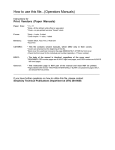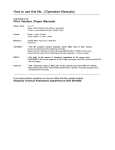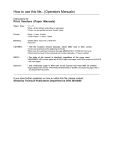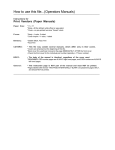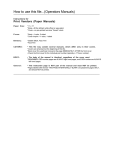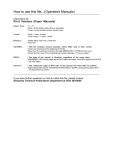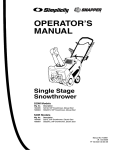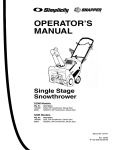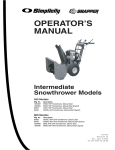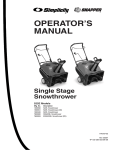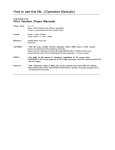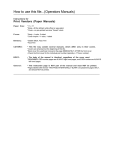Download Simplicity 1693651 860M Operator`s manual
Transcript
How to use this file...(Operators Manuals) ————————————————————————————————————————————––– Instructions for Print Vendors (Paper Manuals) Paper Size: * 11 x 17 * Body—50 lbs brilliant white offset or equivalent. * Cover—on pre-printed two-tone “Swash” stock. Press: * Body—1-color, 2-sided * Cover imprint —1-color, 1-sided Bindery: * Saddle Stitch, Face Trim * Face Trim COVERS: * This file contains several manuals, which differ only in their covers. * Covers are all present at the beginning of this file. * Back cover for a particular manual is the page IMMEDIATELY AFTER the front cover. • Check the front cover for the individual part number (typically a 171xxxx number). BODY: • The body of the manual is identical, regardless of the cover used. * REMEMBER: ODD number pages are ALWAYS right hand pages, and EVEN number are ALWAYS left hand pages. General: * This instruction page is NOT part of the manual and must NOT be printed. • Pages labeled with the text “THIS PAGE INTENTIONALLY BLANK” are placement pages ONLY, and should NOT be printed. ————————————————————————————————————————————––– If you have further questions on how to utilize this file, please contact Simplicity Technical Publications Department at (262) 284-8647. THIS PAGE INTENTIONALLY BLANK OPERATOR’S MANUAL Large Frame Snowthrower 860M LargeFrame Snowthrower Mfg. No. 1693650 1693651 1693763 1693775 Description 860M, 8HP Snowthrower 860M, 8HP Snowthrower (Export) 860M, 8HP Snowthrower 860M, 8HP Snowthrower (Export) 1720535-01 Rev 4/2000 TP 100-2292-01-LW-S MANUFACTURING, INC. 500 N Spring Street / PO Box 997 Port Washington, WI 53074-0997 www.simplicitymfg.com © Copyright 2000, Simplicity Manufacturing, Inc. All Rights Reserved. Printed in USA. Table Of Contents REGULAR MAINTENANCE Normal Care Chart ................................................12 Off-Season Storage ..............................................12 Starting After Storage ...........................................12 Checking Auger Gear Case Lubrication ...............12 Checking Tire Pressure ........................................13 Lubrication ............................................................13 TROUBLESHOOTING, ADJUSTMENT, & SERVICE Troubleshooting Chart .....................................14-15 Traction Drive System Adjustment........................16 Speed Selector Pivot Adjustment ....................16 Traction Drive Clutch Rod & Spring Adj ...........16 Auger Drive System Adjustment ...........................17 Auger Drive Clutch Rod Adjustment ................17 Belt Replacement..................................................18 Shear Pin Replacement ........................................19 Discharge Control Adjustment ..............................20 Chute Direction Control Bracket Adjustment ........20 SPECIFICATIONS ......................................................21 REPLACEMENT PARTS & ACCESSORIES .............22 TECHNICAL MANUAL AVAILABILITY .....................22 SAFETY RULES General ...................................................................2 Preparation .............................................................2 Operation ................................................................3 Maintenance & Storage ..........................................3 Safety Decals ..........................................................4 CONTROL REFERENCE CHART Snowthrower Controls.............................................5 Engine Controls ......................................................5 CONTROLS Starting Controls .....................................................6 Ground Speed Controls ..........................................7 Auger Control ..........................................................7 Deflector Controls ...................................................7 Scraper Height Control ...........................................7 Traction Lock Control ..............................................7 OPERATION General ...................................................................8 Checks Before Each Start-Up .................................8 Starting The Engine ................................................9 Operating The Snowthrower ...................................9 Engine Speed .........................................................9 Ground Speed Selector ........................................10 Deflector................................................................10 Scraper Bar & Skid Shoes ....................................10 FreeWheeling/Traction Drive Lock........................11 After Each Use ......................................................11 For easy reference, please record the information on the chart below. WARNING You must read, understand and comply with all safety and operating instructions in this manual before attempting to set-up and operate your snowthrower. The Snowthrower Reference Data can be found on the identification tag located on the unit’s rear frame. (Refer to the Engine Owner’s Manual for location of engine information serial number.) Failure to comply with all safety and operating instructions can result in loss of machine control, serious personal injury to you and /or bystanders, and risk of equipment and property damage. The triangle in the text signifies important cautions or warnings which must be followed. SNOWTHROWER REFERENCE DATA Model Description/Number M/N (Manufacturer’s Number) S/N (Serial Number) Dealer Name Date Purchased WARNING ENGINE REFERENCE DATA Engine exhaust from this product contains chemicals known, in certain quantities, to cause cancer, birth defects, or other reproductive harm. Engine Make/Model © Copyright 2000 Simplicity Manufacturing, Inc. All Rights Reserved. Printed In USA. TP 100-2292-01-LW-S 1 Engine ID/Serial Number Safety Rules WARNING WARNING This unit is a “two-stage” snowthrower. To avoid serious injury, do not put your hands into the auger housing or discharge chute. If auger stalls or chute becomes plugged, use the following procedure to remove objects or clear the chute: The first stage is the auger, which feeds the snow back into the impeller housing. The second stage is the impeller, which throws the snow out the discharge chute. If bodily contact is made with the auger or impeller when they are rotating, severe personal injury will occur. 1. 2. 3. 4. 5. 6. To avoid injury, keep others and yourself away from the auger and the discharge chute whenever the engine is running. Read and follow all of the safety rules and warnings in this manual. GENERAL Release both the Drive and Auger Control levers. Shut off the engine. Remove the Engine Key. Wait for moving parts to stop. Disconnect spark plug wire. Use a narrow board to remove foreign objects and clear the chute or auger. Never put your hands into the auger or discharge chute. PREPARATION • Read the Operator’s Manual carefully. Be thoroughly familiar with all controls and proper equipment use. • Never attempt to make any adjustment while engine is running. • Never allow children to operate the machine. Do not allow adults to operate it without proper instruction. • Thoroughly inspect the area where the snowthrower is to be used and remove all objects such as door mats, sleds, boards, wires and sticks. • Keep the area of operation clear of all persons, particularly small children and pets. • Disengage all clutches (release Drive and Auger Control levers) before starting engine. • Never discharge material toward any person or pet. a. snowthrower is in good operating condition; • Do not operate snowthrower without wearing proper winter clothing. Wear footwear which improves footing on slippery surfaces. b. all safety devices and shields are in place and working; • Adjust Skid Shoe height to clear gravel or crushed rock surface. c. all adjustments are correct. • Handle gasoline with care - it is highly flammable. • Make sure: a. Use approved gasoline container. b. Never remove the fuel tank cap or add gasoline to a running or hot engine. c. Never fill the fuel tank indoors. d. Wipe up spilled gasoline. • Do not run engine indoors. Exhaust fumes are deadly. 03 2 Safety Rules OPERATION MAINTENANCE & STORAGE • Keep hands and feet away from rotating parts. Keep clear of discharge opening at all times. • Keep all nuts, bolts and screws tight to ensure that the equipment is in safe operating condition. • Always clear snow up and down the face of slopes, never across the face. Use extreme caution when changing direction on slopes. Do not attempt to clear slopes over 17.7% (10o). • Never store equipment with gasoline in the tank in a building where fumes may reach an open flame or spark. Allow the engine to cool before storing in any enclosure. • Use extreme caution when operating on or crossing gravel drives, walks or roads. Stay alert for hidden hazards and traffic. • Always refer to the Operator’s Manual for important details if snowthrower is to be stored for an extended period. • Be especially careful not to touch snowthrower parts which might be hot from operation. Allow such parts to cool before attempting to maintain, adjust or service. • Run auger drive a few seconds after completion of throwing snow to help clear out snow and prevent icing and freeze-up on unit. • If unit starts to vibrate abnormally, disengage drives and stop the engine. Check immediately for the cause. Vibration is generally a warning of trouble. • Before leaving operator’s position for any reason: - shut off engine, - remove the Engine Key and - wait for all moving parts to stop. • Before cleaning, repairing or inspecting the unit, make certain all moving parts have stopped. Remove the key and then disconnect the spark plug wire to prevent accidental starting. • Always use a grounded, 3-wire plug receptacle for electric starting. • Adjust snow discharge angle for safe flow when operating near glass enclosures, automobiles, window wells, drop-offs, etc. • Do not overload machine capacity by clearing snow at too fast a ground speed. • Never operate machine at high transport speeds on slippery surfaces. Use care when backing up. • Disengage Auger Control when transporting or not in use. • Never operate the snowthrower without good visibility or light. Always be sure of your footing. • Do not change the engine governor settings or overspeed the engine. • Never direct the discharge chute at bystanders; nor allow anyone in front of the unit while it is operational. • Never operate this machine without all of the proper guards or other safety protective devices in place. 03 3 Safety Decals SAFETY DECALS Safety warning decals are placed at strategic locations on the snowthrower as a constant reminder to the operator of the most important safety precautions. All warning, caution and instructional messages on your snowthrower should be carefully read and obeyed. If any of these decals are lost or damaged, replace them at once. They can be purchased from your local dealer. WARNING TO AVOID SERIOUS INJURY • Read Owner’s Manual before operating unit. • Never allow children to operate snowthrower. • Always direct discharge chute so as to avoid injury to persons—or damage to property • Stop engine and disconnect spark plug wire before removing debris or servicing unit. • Keep all shields and guards in place while running. Part No. 1715556 WARNING / Main Dash Decal DANGER DANGER AVOID INJURY FROM ROTATING BLOWER! Shut off engine before unclogging discharge chute. 1716533 Part No. 1716533 Discharge Chute Danger Decal Part No. 1715555 Auger Control Decal AVOID INJURY FROM ROTATING AUGER! 1716532 Keep hands, feet, and clothing away. Part No. 1716532 Auger Danger Decal Additional engine safety and control decals are supplied by the engine manufacturer. See your local Tecumseh dealer. 03 4 Controls SNOWTHROWER CONTROLS A B Speed Selector Selects Forward Speeds 1 - 5, Reverse Speeds 1 - 2 Drive Control Engages drive to wheels as it is depressed; disengages when released. C Auger Control Engages auger/impeller as it is depressed; disengages when released. D Chute Direction Control Rotates discharge chute to desired direction E Chute Deflector Controls vertical angle snow is thrown. F Chute Deflector Knob Locks chute deflector at desired angle G Skid Shoes Controls height of scraper bar H Traction Lock Pins Engages for drive and disengages for free-wheeling I Headlight (optional) Fore use in low sunlight. A F E B D C I H G Figure 1. Snowthrower Controls ENGINE CONTROLS A Electric Start Button (Optional) B Fuel Valve Turns fuel supply on or off. C Starter Handle Used to start engine A B Activates electric starter C G D Primer Button Primes carburetor for faster cold starting. E Controls engine speed D Throttle Lever F F Engine Key G Choke Knob Figure 2. Engine Controls Prevents starting of engine without key. Stops engine when removed. Adjusts air/fuel mixture 03 5 E Controls STARTING CONTROLS A B Electric Start Units Only A. Electric Start Button - The Electric Start Button (A, Figure 3) activates an electric starter mounted to the engine, eliminating the need to pull the starter handle. The Electric Start Button operates on 120 Volts AC, which is provided by connection to the extension cord provided with units equipped with this feature. Connect this extension cord ONLY to a properly grounded 3 prong electrical outlet. C G All Models B. Fuel Valve - The fuel valve (B, Figure 3) is located under the fuel tank. It is used to turn the fuel supply off for out-of-season storage. D F C. Starter Handle - The starter handle (C, Figure 3) connects to a starter cord to manually start the engine. Pulling starter handle rapidly spins the engine crankshaft, cycles the engine, and generates the spark necessary for starting the engine. E Figure 3. Engine Controls A. B. C. D. E. F. G. D. Primer Button - When pressed, the primer button (D, Figure 3) provides initial fuel to help start a cold engine. Normally, pressing the primer button twice will provide enough fuel to start a cold engine. Electric Start Button (Optional) Fuel Valve Starter Handle Primer Button Throttle Lever Engine Key Choke Knob E. Throttle Lever - The throttle lever (E, Figure 3) controls the engine speed. For best overall performance, the throttle lever should be set to the FAST position. Use the SLOW position only for warming the engine, or to help prevent snow/ice freeze-up when shutting the unit down for the day. F. Engine Key - The Engine Key (F, Figure 3) prevents the engine from being started by unauthorized individuals. The key must be fully inserted into the key slot for the unit to start. The key is also used to stop the engine by pulling the key out of the key slot. G. Choke Knob - The Choke Knob (G, Figure 3) adjusts the air/fuel mixture, and is used to help start a cold engine by providing a richer mixture. Once the engine is warm and running smoothly, the Choke Knob should be set to the off position to provide a normal air/fuel mix. 03 6 Controls GROUND SPEED CONTROLS A C A. Speed Selector - This lever (A, Figures 4 & 5) is used to set the ground speed of the snowthrower. B D The snowthrower has five forward speeds, 1–5, and two reverse speeds, 1–2. No neutral position or gate is required, since the traction drive design automatically provides "neutral" (no forward or reverse movement), whenever the Drive Control is released. B. Drive Control - This control engages the traction drive as the lever (B, Figures 4 & 5) is depressed, and disengages the traction drive when the lever is released. The traction drive provides power to the wheels. NOTE: Changing ground speeds must only be done while the Drive Control is in the disengaged (fully released) position. AUGER CONTROL Figure 4. Operator's Control Position C. Auger Control - The Auger Control clutch lever (C Figures 4 & 5), engages the auger drive (which throws the snow) as the lever is depressed, and disengages the auger drive when the lever is released. A. Speed Selector B. Drive Control C. Auger Control D. Chute Direction Control DEFLECTOR CONTROLS D C D. Chute Direction Control - The Chute Direction Control (D, Figures 4 & 5), allows the discharge chute to be rotated to throw snow in the desired direction. Snow may be thrown at any angle from straight left, to straight forward, to straight right. A F E B I E. Chute Deflector - Controls the distance snow is thrown. Tilting the Chute Deflector (E, Figure 5) UP provides a higher stream and greater distance, while tilting the deflector DOWN provides a lower stream and less distance. F. Chute Deflector Knob - This knob (F, Figure 5) allows the discharge Chute Deflector (E) to be locked in the desired tilt position. SCRAPER HEIGHT CONTROL H G. Scraper Bar Height Control - The Skid Shoes (G, Figure 5) control the height the scraper bar (located at the bottom of the auger housing). The scraper bar allows smooth surfaces (such as concrete or asphalt driveways) to be scraped clean of snow. On surfaces such as gravel, the scraper bar should be adjusted higher — so that it will not pick up gravel or debris. G Figure 5. Snowthrower Controls A. B. C. D. E. TRACTION LOCK CONTROL 03 H. Traction Lock Pins - The traction drive to each wheel can be locked and unlocked with the Traction Lock Pins (H, Figure 5) to permit the unit to “freewheel,” allowing easier manual handling and transport of the snowthrower. 7 Speed Selector Drive Control Auger Control Chute Control Chute Deflector F. G. H. I. Chute Deflector Knob (Behind) Skid Shoes Traction Lock Pins Headlight (Optional) Operation GENERAL OPERATION CHECKS BEFORE EACH START-UP WARNING 1. Make sure all safety guards are in place and all nuts, bolts and clips are secure. To avoid serious injury, do not put your hands into the auger housing or discharge chute. If auger stalls or chute becomes plugged, use the following procedure to remove objects or clear the chute: 2. Check the engine oil level. See your engine Owner’s Manual for procedure and specifications. 1. 2. 3. 4. 5. 6. 3. Check to make sure spark plug wire is attached and spark plug is tightened securely. If necessary, torque spark plug to 15 ft. lbs. 4. Check the fuel supply. Fill the tank no closer than 1/4 to 1/2 inch of top of tank to provide space for expansion. See your engine Owner’s Manual for fuel recommendations. 5. Check the Scraper Bar to make sure it is set at the desired height. Adjust the Skid Shoes if necessary. (See page 10.) Release both the Drive and Auger Control levers. Shut off the engine. Remove the Engine Key. Wait for moving parts to stop. Disconnect spark plug wire. Use a narrow board to remove foreign objects and clear the chute or auger. Never put your hands into the auger or discharge chute. WARNING 6. Check the Drive Control (B, Figure 6), and Auger Control (C, Figure 1) for proper operation. If adjustment is required, see the Service section for procedures. For your safety, operation on slopes should be in an up and down direction only. If it becomes necessary to move across the face of a slope, use caution and do not blow snow. Be very careful when changing direction on a slope. 7. Check the Chute Direction Control (D, Figure 1) for proper operation. The discharge chute should rotate freely in both directions. See the Service section for adjustment procedures and troubleshooting. Proper winter footwear is recommended for the operator to help prevent slipping. Never attempt to clean snow from excessively steep slopes. The maximum slope for any operation is 17.7% (10º). 8. Check the Chute Deflector (E, Figure 1) for proper operation. The deflector should pivot freely up and down when the Chute Deflector Knob is loosened. If adjustment is required, see the Service Section for procedures. WARNING 9. Position the chute at the desired starting direction and set the deflector at the desired angle. Gasoline is highly flammable and must be handled with care. Never fill the tank when the engine is hot or running. Always move outdoors to fill the tank. Keep snowthrower and gasoline away from open flame or spark. 10. Check the Speed Selector (A, Figure 1) for smooth operation. The control must move freely into each speed position gate and remain in position when released. If the Speed Selector does not move freely into all forward and reverse speed positions, contact your local authorized dealer for assistance. 03 8 Operation STARTING THE ENGINE A B 1. Turn the fuel valve (B, Figure 6) to the ON position. 2. Insert the Engine Key (F) into the Engine Key slot and push fully in to the RUN position. 3. Move the Throttle Lever (E) fully up to the FAST position. 4. Turn the Choke Knob (G) fully clockwise if engine is cold. (Do not choke a warm engine.) 5. Push the Primer Button (D) two times if engine is cold. (Do not prime a warm engine.) 6. Pull Starter Handle (C) rapidly, or push Starter Button if equipped with the electric start. Do not allow the Starter Handle to snap back—let the starter rope rewind slowly—while keeping a firm grip on the Starter Handle. 7. As the engine starts and begins to operate evenly, turn the Choke Knob (G) slowly counter-clockwise to the OFF position, and set the Throttle Lever to SLOW. If the engine falters, turn the Choke Knob clockwise until the engine runs smoothly, and let it run briefly before returning the choke to the OFF position. NOTE: Allow the engine to warm up at SLOW throttle for a few minutes before operating the snowthrower at full speed. The engine will not develop full power until it reaches operating temperature. C G D F E Figure 6. Engine Controls A. B. C. D. E. F. G. Electric Start Button (Optional) Fuel Valve Starter Handle Primer Button Throttle Lever Engine Key Choke Knob OPERATING THE SNOWTHROWER 1. Rotate the discharge chute to the desired direction. 2. Set the Speed Selector to the desired forward speed. 3. Fully press and hold the Auger Control (C, Figure 7) on the right-hand grip to begin auger rotation. To disengage the auger, completely release the lever. 4. Fully press and hold the traction Drive Control lever (B, Figure 7) on the left-hand grip to engage the traction drive and begin moving the snowthrower. To disengage the traction drive, completely release the lever. 5. Select forward or reverse speeds as needed using the Speed Selector (A, Figure 7). Release the Drive Control lever whenever changing drive speeds. NOTE: After 5 - 10 hours of use, it may be necessary to adjust the tension on the traction drive rod. See "Traction Drive Clutch Rod Adjustment" in the Service Section for the adjustment procedure. C A D Figure 7. Operator's Control Position A. Speed Selector B. Drive Control ENGINE SPEED For overall best performance, run the snowthrower at full engine operating speed. Use the engine Throttle Lever (E, Figure 6) to set the engine speed. Slide the Throttle Lever UP to increase engine speed, and DOWN to reduce speed. 03 9 C. Auger Control D. Chute Direction Control B Operation GROUND SPEED SELECTOR A Use the Speed Selector (A, Figure 8) to control the drive speed of the snowthrower. There are five forward speeds and two reverse speeds. Use the lower speeds to blow deep or wet snow. Use the higher speeds to blow light snow or to drive the snowthrower without blowing snow. To change speeds, first release the traction Drive Control lever (B, Figure 8), then move the Speed Selector to the desired speed setting. Fully press the traction Drive Control lever to resume operation. B DEFLECTOR The distance of the discharged snow is mainly controlled by the position of the deflector (Figure 9). (Engine speed also affects distance of discharge.) Figure 8. Ground Speed Selector The more the deflector is tilted UP, the farther snow will be thrown. Loosen the deflector knob, tilt the deflector UP or DOWN, and then retighten the knob when the desired angle has been chosen. A. Speed Selector SCRAPER BAR & SKID SHOES On smooth surfaces such as concrete or asphalt, the scraper bar should scrape the surface. On surfaces such as gravel, the scraper bar should be high enough so that it will not pick up gravel or debris. The height of the scraper bar is controlled by raising or lowering the Skid Shoes (See Figure 10). 1. To raise the scraper bar height, rest the scraper bar on a strip of wood equal in thickness to the desired height. 2. Make sure the scraper bar is parallel to the ground surface. 3. Loosen the skid shoe nuts and let the skid shoes drop to the surface. 4. Tighten the nuts, making sure the Skid Shoes are adjusted equally and are parallel to the surface. 5. To lower the height of the scraper bar, raise the Skid Shoes. 6. If the scraper bar or skid shoes become worn, they can be replaced by removing the hardware attaching them to the snowthrower. Chute Deflector Knob Chute Deflector Figure 9. Chute Deflector Adjustment Scraper Bar Skid Shoe Nuts Skid Shoe Figure 10. Skid Shoe Adjustment 03 10 Operation FREE-WHEELING AND TRACTION DRIVE LOCK Klik-Pin In OUTER Hole For easy turning when pushing the snowthrower, you can disengage the traction drive at one or both wheels by using the Traction Lock Pins (See Figures 11 & 12.) 1. Turn the unit off, remove the Engine Key, and disconnect the spark plug wire. 2. To DISENGAGE the traction drive lock, insert the Traction Lock Pin through the outer hole in the axle. (See Figure 8). 3. To ENGAGE the traction drive lock, insert the pin through the hub and axle (See Figure 9). If the hole in the hub is not aligned with the inner hole in the axle, push the snowthrower until the holes align and install the Traction Lock Pin. Figure 11. Traction Drive Lock - Disengaged Klik-Pin In INNER Hole NOTE: When snowthrowing with the full width of the auger, for best drive performance engage both wheels. For easier turning when not using the full width of the auger, engage one wheel and use the engaged side as the snow contact side for the auger. AFTER EACH USE Figure 12. Traction Drive Lock - Engaged Normal use of the snowthrower may result in a build-up of packed snow in and around the starter cord housing and around engine controls. Heat from the engine will usually prevent the snow from freezing solid while the unit is running, but after the engine is shut down, some snow may continue melting from engine heat, and later freeze around some moving parts as the unit cools. WARNING Never store snowthrower, with gasoline in engine or fuel tank, in a heated shelter or in enclosed, poorly ventilated enclosures. Gasoline fumes may reach an open flame, spark or pilot light (such as a furnace, water heater, clothes dryer, etc.) and cause an explosion. After each period of use, follow these steps to prevent freeze-up caused by ice formation in and around the engine controls and external parts. 1. Before shutting off the engine, pull the starter rope out 2 - 3 times, and allow it to rewind slowly. This will help clear packed snow from the starter cord area. Handle gasoline carefully. It is highly flammable and careless use can result in serious fire damage to people and property. 2. Stop the engine by moving the Throttle Lever (See Figure 8) down, or by pulling out the Engine Key. Drain fuel into an approved container outdoors away from open flame or sparks. 3. Disconnect the spark plug wire, and position it away from the spark plug. 4. Brush snow and ice from the snowthrower. Be sure to clear engine and snowthrower controls, discharge chute, worm and chute rod gears, clutch rod areas, and anywhere else snow has accumulated. 6. If the snowthrower is kept in a cold shelter, fill the fuel tank to prevent condensation. Do not store near sparks or flame. 5. Always remove the Engine Key and store in a safe place to prevent unauthorized use. Note: The Engine Owner’s Manual contains further information on preventing ice formation and freeze-up. 03 11 Regular Maintenance NORMAL CARE CARE REQUIRED FREQUENCY LUBRICATION Check auger gear case lubrication.** 25 Hours Simplicity Winter Weight Worm Gear Oil Lubricate snowthrower. 10 Hours 10W Oil and Grease Check tire pressure. Monthly N/A Change engine oil.*✛ 50 Hours✛ See Engine Manual Yearly See Engine Manual 4-6 Hours N/A Clean or replace spark plug.✛ Check drive linkage/belt tension * Change original oil after two hours of operation. ** Check oil level each fall and spring. ✛ See your engine Owner’s Manual. OFF-SEASON STORAGE 5. Start the engine outdoors. Warm up engine by running at SLOW speed for a a few minutes before running at FAST speed, or blowing snow. 6. Check the operation of all the controls. If necessary, lubricate the snowthrower to improve operation of the chute control. Before you store your snowthrower for the off-season, read the Maintenance and Storage instructions in the Safety Rules section and take the following precautions: NOTE: Gasoline, if permitted to stand unused for extended periods (30 days or longer), may develop gummy deposits which can adversely affect the engine carburetor and cause engine malfunction. To avoid this condition, add Simplicity Gasoline Stabilizer to the fuel tank, or drain all fuel from the system before placing unit in storage. CHECK AUGER GEAR CASE LUBRICATION 1. Place the snowthrower on a level surface. 1. Prepare your snowthrower engine for storage as instructed in the Engine Owner’s Manual. 2. Remove the Pipe Plug (Figure 13). 3. Check the lubricant level. It should be level with the lower edge of the plug opening. If not, add Simplicity Winter Weight Worm Gear Oil (available from your dealer). 2. Lubricate the snowthrower as described in the LUBRICATION section of this manual (page 13). 3. Clean the snowthrower thoroughly. Coat exposed bare metal parts with a quality paint (available from your dealer) or a light film of grease, oil or automotive wax. 4. Re-install Pipe Plug, and tighten securely. 4. Store snowthrower in the wheels down, operating position. Note: If the unit is stored in any other position, oil from crankcase could enter cylinder head, causing a service problem. 5. Store the unit in a protected area and cover. STARTING AFTER STORAGE 1. Remove the spark plug and wipe dry. Crank the engine a few times to blow excess oil out of plug hole. Then reinstall plug. 2. Fill fuel tank with fresh gasoline (unless a fuel stabilizer was used). 3. Check to be sure engine fins are clean and air flow is unobstructed. 4. Check engine oil level and lubricate snowthrower. Change oil if necessary. Pipe Plug Figure 13. Checking Auger Gear Case Lubrication 03 12 Regular Maintenance Figure 14. Checking Tire Pressure Figure 15. Lubricate Points Where Chute Contacts Flange (oil); Lubricate Ring Gear and Pinion Gear While Rotating Spout (grease) CHECKING TIRE PRESSURE The air pressure in each tire should be 20 psi (136 kPa) and should be equal for both tires for best performance. Be sure to keep caps on valves to prevent entry of debris into the valve stem when tires are filled. LUBRICATION IMPORTANT NOTE It is very important that grease fittings on the auger shaft are lubricated regularly. If auger rusts to shaft, damage to worm gear may occur if shear pins do not break. To prevent wheels rusting to axles, it is also necessary to remove the wheels and grease the axles regularly. Figure 16. Lubricate Point Where Control Rods Pass Through Bracket. Remove wheels and grease axles once each year. There are two grease fittings on the auger shaft (Figure 13). Wipe the fittings clean and apply grease, using a grease gun. Also apply grease on other points indicated. Apply medium weight (10W) oil to points shown(See Figures 15 - 18). Generally, all moving metal parts should be oiled where contact is made with other parts. Keep oil and grease off belts, pulley grooves, drive disc, and friction disc. Figure 17. Grease Axles & Lubricate Control Levers See lubrication notes at bottom of page. LUBRICATION NOTES: 1.Grease locations indicated by grease gun symbol: Use grease fittings when present. Disassemble parts to apply grease to moving parts when grease fittings are not installed. 2.Oil locations indicated by oil can symbol: Do not allow oil to drip onto traction drive or friction disc. Figure 18. Lubricate Deflector Hinges 04 13 Troubleshooting, Adjustments, & Service TROUBLESHOOTING This section provides troubleshooting and service instructions. Locate the problem and check the possible cause/remedy in the order listed. WARNING Before performing any adjustment or service to snowthrower, stop the engine and wait for moving parts to stop. Remove the key. To prevent accidental starting, disconnect the spark plug wire and fasten away from the plug. Also, refer to the engine manufacturer’s Owner’s Manual for additional information. For problems not covered here, contact your local dealer. PROBLEM Engine fails to start. POSSIBLE CAUSE 1. 2. 3. 4. 5. Key is OFF. Failure to Prime cold Engine Fuel valve is in CLOSED position. Out of fuel. Choke OFF - cold engine. 6. Engine flooded. 7. Spark plug not sparking. 8. Water in fuel, or old fuel. Engine starts hard or runs poorly. Auger does not rotate. REMEDY 1. 2. 3. 4. 5. Push key in to the ON position. Press Primer Button twice and restart. Turn valve to OPEN position. Fill fuel tank. Turn choke to ON, set throttle to FAST. 6. Turn choke to OFF; try starting. 7. Check gap. Gap plug, clean electrode, or replace plug as necessary. 8. Drain tank (Dispose of fuel at an authorized hazardous waste facility). Fill with fresh fuel. 1. Fuel mixture too rich. 1. Move choke to OFF position. 2. Carburetor adjusted incorrectly. 2. See your dealer for adjustments. 3. Spark plug faulty, fouled, or gapped improperly. 3. Clean and gap, or replace. 4. Fuel Cap Vent is blocked. 4. Clear vent. 1. Auger Control not engaged. 2. Foreign matter blocking auger. 1. Engage Auger Control. 2. STOP engine and REMOVE the key. DISCONNECT the spark plug wire. Clear auger using a narrow board. See warning in SAFETY RULES. 3. Tighten to remove slack. See auger clutch rod adjustment. 4. Check auger drive belt adjustment. 5. Replace belt. 6. Replace shear pin. 3. Auger drive clutch rod slack. 4. Auger drive belt slipping. 5. Broken belt. 6. Shear pin broken. 03 14 Troubleshooting, Adjustments, & Service PROBLEM Auger rotates, but snow is not thrown far enough POSSIBLE CAUSE REMEDY 1. Chute Deflector too low. 1. Adjust deflector as necessary. 2. Engine speed too slow. 2. Set speed to full throttle. 3. Ground speed too fast. 3. Use slower Speed Selector setting. 4. Snowthrower discharge chute clogged. 4. STOP engine and REMOVE the key. DISCONNECT the spark plug wire. Clear auger using a narrow board. See warning in SAFETY RULES. 5. Auger belt loose or worn. 5. Check Auger Drive Belt Adjustment Scraper bar does not clean hard surface. 1. Skid Shoes improperly adjusted. 1. RAISE Skid Shoes (this lowers the Scraper Bar). Scraper bar picks up and throws stones on gravel drive. 1. Skid shoes improperly adjusted. 1. LOWER Skid Shoes (this raises the scraper bar.) Poor traction 1. Tires slipping. 1. Check tire pressure and tread. Auger does not stop when auger lever is released 1. Auger clutch rod too tight or bent. 2. Auger drive belt out of adjustment. 3. Auger belt guide out of adjustment. 1. Loosen or straighten clutch rod. 2. Adjust auger belt. 3. Adjust auger belt guide. Snowthrower does not stop when drive lever is released 1. Traction drive clutch rod bent or too tight. 1. Loosen rod to remove slack or replace. See adjustment procedure. Snowthrower does not drive when drive lever is engaged. 1. Traction drive clutch rod loose. 1. Tighten to remove slack. See adjustment procedure. 2. Replace drive belt. 3. Replace chain. 4. Change Traction Lock Pins to INNER hole to engage traction drive. 5. Replace Disc (see your dealer). 2. Drive belt loose, broken, or stretched. 3. Drive roller chain damaged. 4. Traction Lock Pins in Free-Wheeling position (OUTER hole). 5. Friction Disc worn. Discharge control is difficult to operate. 1. Gearing needs lubrication 2. Worm gear not adjusted properly. 3. Control rod gears misaligned. 1. Oil or grease as required. 2. Adjust worm gear. See adjustment procedure. 3. Adjust gear bracket. See adjustment procedure. Snowthrower veers to one side. 1. Tires pressure not equal. 2. One wheel is set in Free-Wheeling mode. (Traction Lock Pin is in the OUTER hole). 1. Check tire pressure. 2. Make certain BOTH Traction Lock Pins are in the INNER holes (to engage traction drive). Excessive vibration. 1. Loose parts or damaged auger. 1. STOP engine and REMOVE the key. DISCONNECT the spark plug wire. Tighten all hardware. Replace auger if necessary. If vibration continues, see your dealer. Drive fails to move snowthrower at slow speeds. 1. Traction Drive out of adjustment. 1. Readjust drive, or shift Speed Selector setting up one speed faster. 03 15 Troubleshooting, Adjustments, & Service TRACTION DRIVE SYSTEM ADJUSTMENT A Speed Selector Pivot Adjustment The Speed Selector is factory set for optimal performance at each forward and reverse speed setting. However, if drive system components have been replaced, adjustment may be necessary. Adjust as follows: 1. Move the ground speed control (A, Figure 19) fully forward. 2. Loosen the hardware (B) securing the upper and lower shift rods. 3. Push the lower rod (C) down fully (into the housing). 4. Make sure the ground speed control (A) is in the full forward (5th gear) position. Tighten the shift rod hardware (B). B C Traction Drive Clutch Rod & Spring Adjustment INITIAL ADJUSTMENT Figure 19. Speed Selector Linkage Adjustment The traction drive clutch rod should initially be adjusted so that there is no slack in the rod when moved slightly from side to side, but bellcrank arm remains in fully down position. To adjust tension on the rod: A. Ground Speed Lever B. Shift Rod Hardware C. Lower Shift Rod 1. Loosen adjustment hex nuts (Figure 20). 2. Tighten bottom hex nut while holding rod. Tighten just until slack in rod is removed. 3. Tighten upper hex nut securely. Adjustment Hex Nuts WARNING Traction Drive Clutch Rod Do not over-tighten, as this may cause traction drive to engage without depressing the traction Drive Control (bellcrank arm must remain in down position). Verify that the rods are not over-tightened: With Speed Selector in position 1 and traction Drive Control fully released, push snowthrower forward. The unit should move forward freely. Traction Drive Bellcrank Arm If unit does not move forward freely, the rod has been over-tightened. To remedy, loosen tension on clutch rod slightly, and recheck. Traction Drive Clutch Rod Spring Figure 20. Traction Drive Clutch Rod Adjustment 03 16 Troubleshooting, Adjustments, & Service AUGER DRIVE SYSTEM ADJUSTMENTS Auger Drive Clutch Rod Auger Drive Clutch Rod Adjustment WARNING Auger Lever Do not over-tighten, as this may lift the idler rod lever and cause auger drive to be engaged without depressing the Auger Control. Adjustment Hex Nuts Auger Drive Clutch Rod Spring All auger drive adjustment is accomplished through the auger drive clutch rod. The rod must be adjusted so that there is 1/32” clearance between the spring hook and the auger lever (see Figure 21). Proper adjustment allows the auger brake to engages when the control is released. To adjust the rod: Must have 1/32” gap between spring hook and lever. 1. See Figure 21. Loosen adjustment hex nuts. Figure 21. Auger Drive Clutch Rod adjustment 2. Tighten the upper adjustment nut until there is a 1/32” gap between the spring hook and the auger lever. 3. Tighten the lower adjustment nut. 4. Recheck that there is a 1/32” gap between the spring hook and the auger lever. 5. With engine running, fully depress Auger Control, the auger should engage and run normally. 6. Release Auger Control. The auger must stop within 5 seconds. 7. If auger does not operate properly, stop engine and recheck clutch rod adjustments. 03 17 Troubleshooting, Adjustments, & Service Belt Cover Screws Figure 22. Belt Cover Figure 23. Auger Pulley Belt Stops (shown with bottom cover removed) A. Nuts B. Belt Stops C. Auger Pulley BELT REPLACEMENT 1. Rotate the spout full right. Loosen the two screws (Figure 22) securing the belt cover. 2. Tilt the cover forward and work it off the snowthrower. 3. Remove the belt guide (B, Figure 24) by removing the two capscrews (A), lockwashers and washers. 4. Remove the auger drive belt as follows: a. Slip the auger drive belt (D, Figure 24 from the idler pulley by pushing it away from the pulley and then toward the rear. b. Remove the belt from the engine pulley. Slip the belt from under the brake pad. c. Remove six capscrews from bottom cover to snowthrower frame. Loosen nuts (A, Figure 24) on each side to release auger pulley belt stops (B, Figure 23). Move belt stops and remove belt from pulley (C, Figure 23). d. Belt can be removed from top or bottom. For more clearance to remove the belt, engage the traction drive lever. 5. Remove the traction drive belt as follows: a. Pull the idler pulley (I, Figure 24) away from the belt and slip the belt from the pulley. b. Slip the belt off the traction pulley and then the engine pulley. The arm for the front idler pulley (G, Figure 24) may have to be pivoted to provide clearance for removing the belt from the traction pulley. c. Pull the belt out between the auger pulley (F, Figure 24) and traction pulley. A C B D E A F I H G Figure 24. Belts and Pulleys A. B. C. D. E. Capscrews Belt Guides Traction Drive Belt Auger Drive Belt Engine Pulley F. G. H. I. Auger Pulley Idler Pulley, Auger Traction Pulley Idler Pulley, Traction 03 18 Troubleshooting, Adjustments, & Service 6. Reverse the procedure to install the belts. Be sure there are no twists and the belts are properly seated in the grooves. Adjust the belt stops so there is 1/8” (3mm) clearance between belt and stop. The pattern for both belts is shown in Figure 25. 7. Check the traction drive tension and auger drive tension. Follow the procedures under AUGER DRIVE BELT ADJUSTMENT. 8. Make sure the auger stops when the auger drive lever is released. Make sure traction drive stops when the traction drive lever is released. If not, check the drive tension. If a problem exists, see your dealer. Belt Stops A C B D Belt Stops (Auger Pulley Only) Figure 25. Belt Pattern (as viewed from front of snowthrower) A. Engine Pulley B. Drive Belt C. Idler Pulley D. Driven Pulley SHEAR PIN REPLACEMENT WARNING Do not go near the discharge chute or auger when the engine is running. Do not run the engine with any cover or guard removed. Under most circumstances, if the auger strikes an object which could cause damage to the unit, the shear pin will break. (This protects the gear box and other parts from damage.) The shear pins are located on the auger shaft as shown in Figure 26. To replace the shear pins, tap out broken pin with a pin punch, and install a new shear pin and cotter pin. Spread the legs of the new cotter pin fully. Do NOT replace shear pins with anything other than the correct grade replacement shear pin. See the REPLACEMENT PARTS section at the back of this manual for the correct part numbers. (Use of bolts, screws or a harder shear pin will lead to damaged equipment.) Shear Pins Figure 26. Shear Pins 03 19 Troubleshooting, Adjustments, & Service DISCHARGE CONTROL ADJUSTMENT F A If the discharge chute is difficult to operate, first lubricate the pinion gear (A, Figure 27) and ring gear (F). If it is still difficult to operate, adjust as follows: E 1. Loosen the nut (G, Figure 27) which holds the pinion gear bracket in the slotted hole. 2. If the pinion gear is too tight against the ring gear, move it away slightly and then retighten the nut. B 3. Check the operation again. D C G Figure 27. Discharge Control A. B. C. D. Pinion Gear Control Rod Carriage Bolt Slotted Bracket E. U-shaped Bracket F. Ring Gear G. Nut CHUTE DIRECTION CONTROL GEAR BRACKET ADJUSTMENT If the Discharge Chute becomes difficult to rotate or begins to operate erratically, the Chute Direction Control rod gears may require adjustment: 1. Loosen the gear bracket mounting nuts (Figure 28). 2. Slide the gear bracket into the position that provides the best engagement between the gears. 3. Tighten the bracket mounting nuts, and check for smooth operation. Mounting Nuts 4. Readjust if necessary. 5. Lubricate the Chute Direction Control rod gears with a medium weight (10W) oil. Figure 28. Chute Direction Control Gear Bracket Adjustment 03 20 Specifications ENGINE AUGER Make ................................................................Tecumseh Cylinders........................................................................1 Construction.............................Ribbon flite welded steel Bearings ...................................................Self-lubricating Cycles.............................................................................4 Crankshaft .......................................................Horizontal IMPELLER 8 HP - Model No. .....................................See engine I.D. plate - Bore & Stroke ..............................3-1/8 in. x 2-17/32 in. (79.90 mm x 64.31 mm) - Displacement .............................................19.43 cu. in. (318.30 cc) Construction..............................................4 steel blades Ignition ...............................................................Magneto Type....................Cushion V-belt and worm gear housing Bearings ..............Pre-lubricated and sealed ball bearing Diameter.....................................................12 in. (30 cm) AUGER & IMPELLER DRIVE Governor........................................................Mechanical Choke ...................................................................Manual OVERALL DIMENSIONS & WEIGHT Lubrication ...............................................Splash system Model 8-60M - Length ....................................................54 in. (137 cm) - Width ........................................................26 in. (65 cm) - Height.....................................................43 in. (109 cm) - Weight .................................................236 lbs. (107 kg) Oil Capacity ......................................See engine manual Fuel Capacity....................................See engine manual TRACTION DRIVE Type...........................Friction drive transmission w/chain gear drive and speed selection Speeds ...............................Five forward and two reverse Axle ....................Solid w/klik-pin lock for two-wheel drive Tire Inflation ..........................................20 psi (137 kPa) AUGER HOUSING Construction..............................Welded steel stampings Effective Width - Model 8-60M ............................................24 in. (60 cm) Auger Opening Height ...........................19 in. (47.5 cm) Spout Rotation ............................................210 degrees Scraper Bar.................High Carbon, wear resistant steel Skid Shoes ........................Adjustable, heat-treated steel SPECIFICATIONS ARE CORRECT AT TIME OF PRINTING AND ARE SUBJECT TO CHANGE WITHOUT NOTICE. 03 21 Specifications COMMON REPLACEMENT PARTS ACCESSORIES Listed below are part numbers for the more common replacement parts. Use only genuine Simplicity replacement parts to assure optimum performance and safety. See your dealer to purchase any of the following accessories for your snowthrower. Simplicity Gas Stabilizer - 8 oz. Bottle........................................................1685748 - Case of 12 Bottles (8 oz. ea.) ...........................1685747 Special Worm Gear Oil for Auger Gear Case - 8 oz. Container .................................................1704636 - Case of 12 Bottles (8 oz. ea.) ...........................1685406 Light for late afternoon and early evening snowthrowing. Light Kit Electric Start Kit (120V AC) Offers operator the convenience of electric starting. Available for all models. Standard on some models. Drift Cutters Simplicity Brand Cold Weather Engine Oil Helps break through drifts. SAE 5W30 SF/CD - Case of 12 Qts..................................................1685576 Shear Pin, Auger...............................................1668344 TECHNICAL MANUAL AVAILABILITY Cotter Pin (for shear pin) ...................................1918447 Additional copies of this manual, as well as a fully illustrated Parts Manuals for your snowthrower are available. The Parts Manuals show all of the assemblies and individual parts as exploded views which show the relationship of the parts and how they go together. Important assembly notes and special torque values are included in the illustrations. Standard hardware and torque specification charts are also included. Skid Shoes (set of 2) .........................................1685501 Auger Drive Belt - Model 860M.........................1666655 Wheel Drive Belt ...............................................1672732 Traction Lock Pin..............................................1666969 Handle Grip .......................................................1671041 Grease Gun Kit..................................................1685510 - 8 oz. Grease Tube..............................................103077 To order copies of the manuals applicable to your model, contact the Simplicity Customer Publications Department at 414-284-8519. Have the following information available when phoning in your request. Touch-Up Paint - Deep Orange Spray Paint (13 oz. can) ............1685611 - Deep Orange Paint (1 qt. can)..........................1685612 - Deep Orange Paint (1/2 oz. dauber) ................1685615 - Solar Black Spray Paint (13 oz. can)................1686779 Model: ___________________________________________________ Equipment Cleaner/Degreaser/Degrimer - 32 oz. Spray Bottle ...........................................1685619 - 1 gallon bottle ...................................................1685621 M/N (Mfg. No.): ____________________________________________ S/N (Serial #): _____________________________________________ Pneumatic Tire Seal - Stops & Prevents Leaks - 11 oz. tube........................................................1685523 - Case of 12 (11 oz. tubes) .................................1685537 - Case of 24 (11 oz. tubes) .................................1685525 Your Name:_______________________________________________ Address: _________________________________________________ City, State, Zip: ____________________________________________ Visa/Mastercard No.: _______________________________________ Card Expiration Date: _______________________________________ Note: Information listed above is correct at time of printing, and are subject to changes in availability and specifications without notice. Part numbers may be superceded by other part numbers. USE ONLY GENUINE SIMPLICITY REPLACEMENT PARTS Available through your local authorized SIMPLICITY dealer. 03 22


























